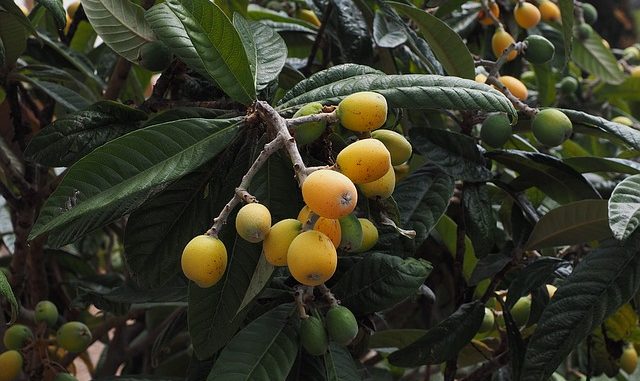
Loquats are an edible exotic in many countries. If you are fortunate to have a sunny south-facing wall, a sheltered courtyard or a greenhouse then why not try growing a loquat. They are very much a feature of the Mediterranean and so evocative of holidays in those southern Spanish and Italian villages by the sea. They are also evergreen trees which make an attractive addition to he garden bearing clusters of golden pear-shaped fruit which is very juicy. Although only expect them to bear this fruit in northern hemispheres when the winter has been mild enough.
The plant is a member of the rose family (Rosaceae). It produces panicles of fragrant, hawthorn like cream coloured flowers in autumn after a warm summer. The plants are self-fertile and the fruit ripens in late winter to early spring but needs warmth and protection. The pear shaped fruits are yellowy orange in colour and up to 5cm across with one or more black or brown shiny seeds.
The fruit is likened to apples, apricots and plums.
The loquat is rich in carotenoids which we have covered elsewhere – that is a strong nutritional benefit not possessed by that many fruits. The fruit is also known as the Japanese medlar, Japanese plum or Chinese plum which indicates where they were first grown. The tree was introduced into Britain around the start of the 18th Century from the cool hills of China. Commercially, they are grown throughout the Far East, Mediterranean and in Florida in the USA.
The fruit needs peeling to reveal a slightly acid but sweet flesh that can be turned into a wine, liqueur or jam and jelly. It is a popular feature of fruit salads and makes an ideal accompanyment to cheese. The fruit is also made into chutney and relish because it has a high pectin content. The seeds also leave a slight almond flavour if they are cooked too.
The leaves are long and large being up to 30 cm with deeply veined, shiny dark green tops and a velvety underneath. The tree can reach to a height between 4 and 10m in 20 to 50 years but is often smaller with a spread of 4m. the tree is hardy throughout the UK and has a hardiness rating of H4 (-10 to -5°C). It only fruits in areas with mild winters and needs protection from the frost. Crops have been obtained infrequently from Cornwall, South Wales and South London.
Growing Requirements
Loquats need a full sun, free draining fertile soil. They are drought tolerant once established. Plants can be effectively restricted by growing them in a large pot using a loam based compost. water the containers moderately and apply a a balanced liquid feed once a month. during the growing season. water sparingly in winter. Little training and pruning is required except to remove diseased wood but prune in spring to restrict growth if required. ideally, grow loquats against a wall or train into bush in a container. They are generally disease free although they suffer like most fruit trees from mealybugs when grown under glass.
Loquats are grown from fresh seed in late spring but they take many years to fruit. They can also be propagated by layering or semi-hardwood cuttings taken from this season’s growth in late summer. Trim cuttings to 10-15cm, cutting just below a node and snip leaves in half to reduce water loss. Place the cuttings in a cutting compost with bottom heat to help rooting. Named cultivars are not available.
After I read the article about nutritional benefits of loquat l thought time to grow them. I always felt they were an interesting fruit to grow having seen these trees in the Med.